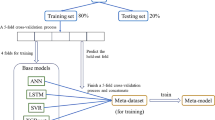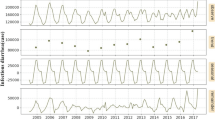Abstract
Diarrhea is one of the leading public health problems and the third main cause of death among young children in developing countries. Solutions to tackling the infectious disease require both preventive and control efforts. However, efforts toward improving the control measures require comprehending the factors associated with diarrhea incidence and the ability to accurately forecast the incidence of the disease. Therefore, the present study develops a diarrhea incidence prediction model based on the 2013 Nigeria Demographic and Health Survey data using artificial neural network. The empirical results of the model indicate that, by using only 44 demographic, socioeconomic and environmental variables, diarrhea incidence can be predicted with high accuracy of 95.78 and 95.63% during training and testing phases, respectively. The model is useful for health policymakers in devising proactive intervention measures, including preparing healthcare systems and improving diarrhea prevention and control capabilities. It could also benefit future studies in predicting epidemics that are affected by similar variables.


Similar content being viewed by others
References
Abubakar IR (2017) Household response to inadequate sewerage and garbage collection services in Abuja, Nigeria. J Environ Public Health 2017:5314840
Abubakar IR (2018a) Exploring the determinants of open defecation in Nigeria using demographic and health survey data. Sci Total Environ 637–638:1455–1465
Abubakar IR (2018b) Strategies for coping with inadequate domestic water supply in Abuja, Nigeria. Water Int 43(5):570–590
Abubakar IR (2019) Factors influencing household access to drinking water in Nigeria. Util Policy 58:40–51
Acharya UR, Bhat PS, Iyengar SS, Rao A, Dua S (2003) Classification of heart rate data using artificial neural network and fuzzy equivalence relation. Pattern Recognit 36(1):61–68
Ashour SK, Ahmed ME (1994) Logistic regression for social-economic and cultural factors affecting diarrhea diseases in children under two years in Egypt. Egypt Popul Fam Plann Rev 28(1):1–18
Chou WC, Wu JL, Wang YC, Huang H, Sung FC, Chuang CY (2010) Modeling the impact of climate variability on diarrhea-associated diseases in Taiwan (1996–2007). Sci Total Environ 409(1):43–51
Clasen T, Pruss-Ustun A, Mathers CD, Cumming O, Cairncross S, Colford JM (2014) Estimating the impact of unsafe water, sanitation and hygiene on the global burden of disease: evolving and alternative methods. Trop Med Int Health 19(8):884–893
Das R, Turkoglu I, Sengur A (2009) Effective diagnosis of heart disease through neural networks ensembles. Expert Syst Appl 36(4):7675–7680
De La Sante OM (1999) Forecasting in communicable diseases. WHO, Regional office for the Eastern Mediterranean. http://applications.emro.who.int/docs/em_RC46_8_en.pdf. Accessed 10 Oct 2016
Duda RO, Hart PE, Stock DG (2001) Pattern classification. Wiley, New York
Gazzeh K, Abubakar IR (2018) Regional disparity in access to basic public services in Saudi Arabia: a sustainability challenge. Util Policy 52:70–80
Gupta KC (2000) Neural network structures. In: Zhang QJ, Gupta KC (eds) Neural Networks for RF and Microwave Design. Artech House, Boston, MA, pp 61–103
Hashizume M, Armstrong B, Hajat S, Wagatsuma Y, Faruque AS, Hayashi T, Sack DA (2007) Association between climate variability and hospital visits for non-cholera diarrhea in Bangladesh: effects and vulnerable groups. Int J Epidemiol 36:1030–1037
Hecht-Nielsen R (1987) Kolmogorov’s mapping neural network existence theorem. In: International symposium on neural networks
Hornik KM, Stinchcombe M, White H (1986) Multilayer feed forward networks are universal approximators. Neural Netw 2(5):359–366
Karabatak M, Ince MC (2009) An expert system for detection of breast cancer based on association rules and neural network. Expert Syst Appl 36(2):3465–3469
Khan MMH, Zanuzdana A, Burkart K, Krämer A (2014) Determinants of diarrhea in ‘Urban slums’ of dhaka and adjacent rural areas: a household-level analysis. Popul Space Place 20(6):498–511
Komarulzaman A, Smits J, de Jong E (2016) Clean water, sanitation and diarrhea in Indonesia: effects of household and community factors. Glob Public Health 12:1–15
Krenker A, Bešter J, Kos A (2011) Introduction to the artificial neural networks. Eur J Gastroenterol Hepatol 19(12):1046–1054
Malav A, Kadam KA (2018) A hybrid approach for heart disease prediction using artificial neural network and K-means. Int J Pure Appl Math 118(8):103–110
Manju T, Priya K, Chitra R (2013) Heart disease prediction system using weight optimized neural network. Int J Comput Sci Manag Res 2(5):2391–2397
Myers MF, Rogers DJ, Cox J, Flahault A, Hay SI (2000) Forecasting disease risk for increased epidemic preparedness in public health. Adv Parasitol 47:309–330
National Population Commission (NPC) [Nigeria] and ICF International (2014) Nigeria demographic and health survey, 2013. National Population Commission (NPC) [Nigeria] and ICF International, Abuja
Olatunji SO (2013) Forecasting the Saudi Arabia stock prices based on artificial neural networks model. Int J Intell Inf Syst 2(5):77
Olatunji SO, Arif H (2013) Identification of erythemato-squamous skin diseases using extreme learning machine and artificial neural network. ICTACT J Softw Comput 4:627–632
Olatunji SO, Selamat A, Abdulraheem A (2011) Modeling the permeability of carbonate reservoir using type-2 fuzzy logic systems. Comput Ind 62(2):147–163
Olatunji SO, Selamat A, Abdulraheem A (2014) A hybrid model through the fusion of type-2 fuzzy logic systems and extreme learning machines for modelling permeability prediction. Inf Fusion 16:29–45
Pande S, Keyzer MA, Arouna A, Sonneveld BG (2008) Addressing diarrhea prevalence in the West African Middle Belt: social and geographic dimensions in a case study for Benin. Int J Health Geogr 7(1):1
Pandey B, Mishra RB (2009) Knowledge and intelligent computing system in medicine. Comput Biol Med 39(3):215–230
Patel VL, Shortliffe EH, Stefanelli M, Szolovits P, Berthold MR, Bellazzi R, Abu-Hanna A (2009) The coming of age of artificial intelligence in medicine. Artif Intell Med 46(1):5–17
Salim N (2004) Medical diagnosis using neural network. http://www.Generation.org/content/2004/. Accessed 23 Apr 2016
Soyiri IN, Reidpath DD (2013) An overview of health forecasting. Environ Health Prev Med 18(1):1–9
US. Department of Health and Human Services (2013) Diarrhea: common illness, global killer. Centers for Disease Control and Prevention. http://www.cdc.gov/healthywater/pdf/global/programs/Globaldiarrhea508c.pdf. Accessed 10 Oct 2016
Van Meijgaard J, Fielding JE, Kominski GF (2009) Assessing and forecasting population health: integrating knowledge and beliefs in a comprehensive framework. Public Health Rep 1:778–789
Waddington H, Snilstveit B, White HLF (2009) Water, sanitation and hygiene interventions to combat childhood diarrhea in developing countries, vol 31. International Initiative for Impact Evaluation, New Delhi
Walker CLF, Perin J, Aryee MJ, Boschi-Pinto C, Black RE (2012) Diarrhea incidence in low-and middle-income countries in 1990 and 2010: a systematic review. BMC Public Health 12(220):1–7
Wang Y, Li J, Gu J, Zhou Z, Wang Z (2015) Artificial neural networks for infectious diarrhea prediction using meteorological factors in Shanghai (China). Appl Soft Comput 35:280–290
WHO (2015) Nigeria: WHO statistical profile. Country statistics and global health estimates by WHO and UN partners. Global Health Observatory, Geneva
WHO, UNICEF (2013) Ending preventable child deaths from pneumonia and diarrhoea by 2025: global action plan for prevention and control of pneumonia and diarrhoea. WHO/UNICEF, New York
Woldemicael G (2001) Diarrhea morbidity among young children in Eritrea: environmental and socioeconomic determinants. J Health Popul Nutr 19(2):83–90
Wolf J, Prüss-Ustün A, Cumming O, Bartram J et al (2014) Assessing the impact of drinking water and sanitation on diarrhea disease in low-and middle-income settings: systematic review and meta-regression. Trop Med Int Health 19(8):928–942
Author information
Authors and Affiliations
Corresponding author
Ethics declarations
Conflict of interest
The authors declare that they have no conflict of interest in the conduct of this research.
Additional information
Communicated by V. Loia.
Publisher's Note
Springer Nature remains neutral with regard to jurisdictional claims in published maps and institutional affiliations.
Rights and permissions
About this article
Cite this article
Abubakar, I.R., Olatunji, S.O. Computational intelligence-based model for diarrhea prediction using Demographic and Health Survey data. Soft Comput 24, 5357–5366 (2020). https://doi.org/10.1007/s00500-019-04293-9
Published:
Issue Date:
DOI: https://doi.org/10.1007/s00500-019-04293-9




